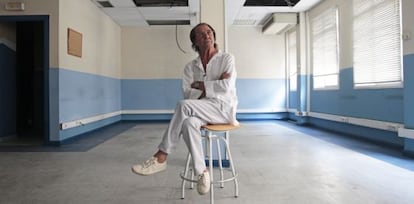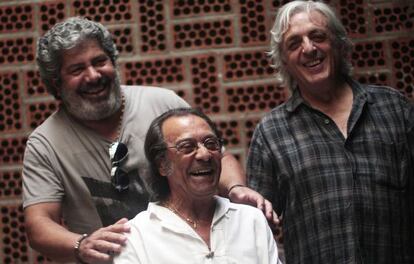World’s first flamenco university gets ready to welcome students in Madrid
Privately run Uflamenco to offer a degree program in the music and dance form from October

On a sweltering late August afternoon in the center of Madrid, workers are putting the finishing touches to what will be the first educational institution anywhere to offer an undergraduate program in that most Spanish of art forms, flamenco.
Uflamenco, or the University of Flamenco, has taken more than a decade to get off the ground, explains Antonio Suárez Salazar, the 59-year-old cantaor, or singer, better known as Guadiana, as he leads us into the welcome cool of the four-story building that in October will open its doors to around 400 students of flamenco dance, singing and guitar from around the world.
Waiting for us inside is Pepe Habichuela, one of Spain’s finest contemporary flamenco guitarists, and patriarch of the Carmona family, from which sprang the three members of the now-defunct group Ketama, which played a lead role in reviving and popularizing flamenco three decades ago.
With him is Pedro Ojesto, composer, performer, and founder of the Escuela de Nuevas Músicas, one of Spain’s most-respected private music colleges. Along with the Carmonas and other partners from Spain’s leading music schools, Ojesto has been a driving force behind Uflamenco.
We are going to attract the best here, and provide students with the highest level of training possible”
“We are going to attract the best here, and provide students with the highest level of training possible,” says Ojesto, who a decade ago published Las claves del flamenco (The fundamentals of flamenco): “The first book to codify every flamenco style in a format that music students can understand, using the same approach as at Berklee, with the goal of providing an understanding of every aspect of flamenco, both musically and technically.”
“We are going to create a sensation here,” says Habichuela, looking round the empty rooms, smiling.
“We’re going to attract students from around the world. That’s why it’s been so important to get official recognition for what will be an innovative program that integrates dance and music,” adds Ojesta.
“I learned my art by playing, playing anywhere and everywhere, but now, with all the experience we have accumulated, we have to help the younger generation with a passion for flamenco, we have to give them all we can,” says Habichuela. “You can have a natural gift, but you still have to learn. And anybody who wants to learn flamenco will have to come here,” adds Guadiana
Ojesto will be supplying students with the theory, while Guadiana and Habichuela will be on hand to explain the finer details of flamenco singing and guitar playing. In charge of dance is another living legend, who like his fellow teachers, also learned his craft the hard way: Antonio Canales. “When I started out, back when I was 17, it was a magical time, but I was also broke and hungry a lot of the time. Now I’m 52 and I feel like a veteran, a young veteran,” he laughs during a telephone interview when asked about how he feels taking up a teaching role: “But it is possible to teach flamenco, despite what many people say about it being a gift, and it is certainly easier to do when you have two unique characters like Habichuela and Guadiana.”

Also on hand at Uflamenco, says Canales, will be some of the country’s finest flamenco and flamenco fusion players, such as singer Juan de la Tomasa, guitarists Josemi Carmona and Mario Montoya, and bassist Javier Colina: “Our approach is the same as the way that jazz is taught,” says Canales.
“The program has been designed with the idea of preserving the way that flamenco has always been taught: orally, but supported by notation. And it works, because the worst flamenco guitarist in the world plays better than somebody who has studied at music school. There is nothing like this in Spain. The only school that combines singing, guitar and dance is in Seville, but its teaching is broken up into different elements. Other than that, there are conservatories still working along lines that went out of date decades ago,” says Ojesto.
Despite the mystery that surrounds it, Ojesto, Habichuela, and Guadiana insist that flamenco is an art form that can be learned by anybody, if you have a feeling for it. “If you feel that there is something missing in your life, and you want to get into something that is going to fill your soul, then try flamenco,” says Guadiana, insisting that his approach will start with the “easiest” of the flamenco styles, soleá: “Play an e chord, an arpeggio, and then pick out the sixth, the third, the second, and the first. Then add a verse, the older the better: that’s the way to start.”
Habichuela adds that while teaching will be based on tradition, “if you ask me, there are few things more modern than a singer and a guitarist.” Ojesto adds that songwriter Juan Antonio Salazar, who has written for giants of the genre such as Camarón de la Isla, will also be giving classes that will look at the way that flamenco can address a wider range of issues than it has traditionally. “Maybe it’s about time that flamenco took a step forward and caught up with the times,” he says.
Tu suscripción se está usando en otro dispositivo
¿Quieres añadir otro usuario a tu suscripción?
Si continúas leyendo en este dispositivo, no se podrá leer en el otro.
FlechaTu suscripción se está usando en otro dispositivo y solo puedes acceder a EL PAÍS desde un dispositivo a la vez.
Si quieres compartir tu cuenta, cambia tu suscripción a la modalidad Premium, así podrás añadir otro usuario. Cada uno accederá con su propia cuenta de email, lo que os permitirá personalizar vuestra experiencia en EL PAÍS.
¿Tienes una suscripción de empresa? Accede aquí para contratar más cuentas.
En el caso de no saber quién está usando tu cuenta, te recomendamos cambiar tu contraseña aquí.
Si decides continuar compartiendo tu cuenta, este mensaje se mostrará en tu dispositivo y en el de la otra persona que está usando tu cuenta de forma indefinida, afectando a tu experiencia de lectura. Puedes consultar aquí los términos y condiciones de la suscripción digital.
Archived In
Últimas noticias
From digital curfews to blocking apps: How technology experts protect their children online
Why the price of coffee has skyrocketed: from Brazilian plantations to specialty coffee houses
Confined to a Cuban hospital: When electricity is a matter of life or death
The complicated life of Francesca Albanese: A rising figure in Italy but barred from every bank by Trump’s sanctions
Most viewed
- Why we lost the habit of sleeping in two segments and how that changed our sense of time
- Pablo Escobar’s hippos: A serious environmental problem, 40 years on
- Trump’s obsession with putting his name on everything is unprecedented in the United States
- The Florida Keys tourist paradise is besieged by immigration agents: ‘We’ve never seen anything like this’
- Charles Dubouloz, mountaineering star, retires at 36 with a farewell tour inspired by Walter Bonatti








































